#missing middle
Explore tagged Tumblr posts
Text

What if… 🙈 we both had houses 👉🏻👈🏻… and they touched? 😳
#urbanism#chicago#missing middle#there is nothing sexier than houses that touch#maybe people in houses that touch riding trains#or like#walking and biking to a park#but mostly the houses that touch#trains#cities
45 notes
·
View notes
Text
#architecture#house design#cottage courts#home construction#missing middle#innovation#affordable housing
3 notes
·
View notes
Text
youtube
About Here (Uytae Lee) looks at why the double-staircase building code limits apartments to one-bedroom or studios, meaning family-sized multi-room apartments can’t be built.
11 notes
·
View notes
Text
Great Idea 2: Missing middle housing
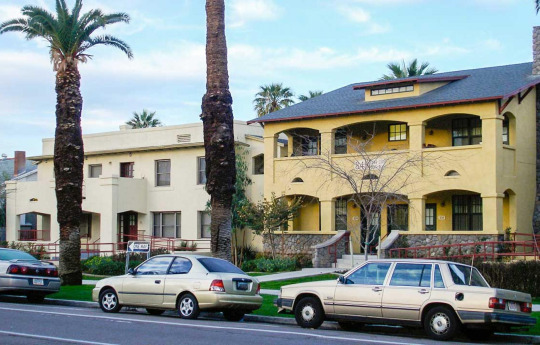
Increasingly in demand today, missing middle housing forms the backbone of the quintessential American neighborhood. Read more.
#great ideas#new urbanism#urban design#urbanism#cities#walkability#missing middle#housing#architecture#urban planning#design
11 notes
·
View notes
Text
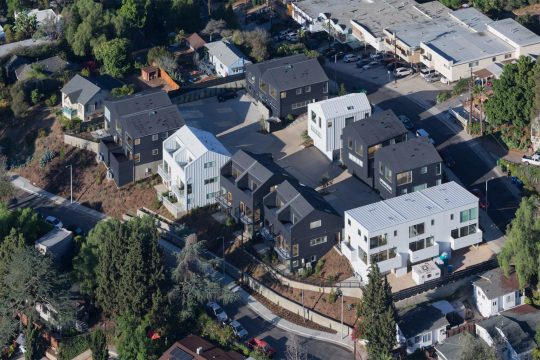
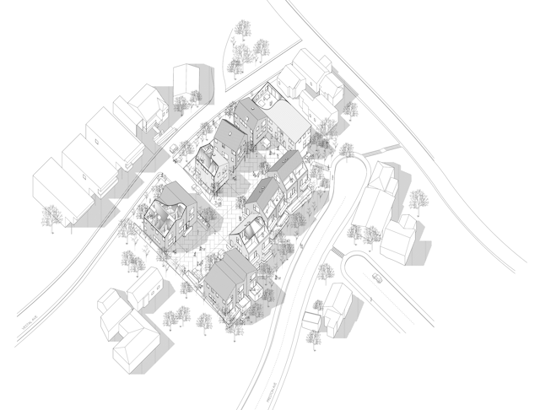
"Stealth Density", "Disguised Density", "Gentle Density"
How Architects tactfully design and pitch infill housing that responds to context and the politics of upzoning.
#stealth density#discussed density#gentle density#upzoning#urban infill#housing#yimby#missing middle#GSD
3 notes
·
View notes
Text
I know I've beaten this drum before, but here we go again: "everybody move to the city" is not the solution to car-culture and urban-design problems. In fact, I think it's part of the problem. Allow me to explain.
tl;dr it's all about the votes
First, let's figure out what "the city" means. Most large cities consist of two parts: a very dense core, and outlying areas which are practically the same as suburbs. Still vast tracts of single-family detached homes, sliced apart by "stroads" that isolate more than they connect. (For those who don't know the term, it's a portmanteau of "street" which is a place of commerce and "road" which is a way to get from one city/town to another. Stroads combine the worst of both, separating what's on either side with high-speed traffic.) A classic example is Detroit, which is one of the largest US cities geographically. The stroad near us when we lived in Detroit was actually worse than the one near us in an adjoining suburb (Hazel Park), in both we were surrounded by other SFD homes, in both we had major highways nearby, a dearth of stores, and so on.
So, "move to the city" can mean one of two different things: moving to the core, or to the outer areas. If you move from the suburbs to an outer area, that's what we in computing call a "no-op" - an instruction that does nothing. Neither the place you left nor the place you went to has or will change, except for a few exceptions I'll get to later. Most importantly, nothing has changed for you. You're still living in basically the same environment (except maybe a bit dirtier and with fewer trees). On the other hand, if you move to the core - the only version of "move to the city" that really means anything at all - you might have well improved conditions for yourself, at the expense of making that core even less affordable. You will also have added to the infrastructure challenges there. "New urbanists" like to talk about the infrastructure costs of sprawly suburbs, but for electrical power in particular there are equal challenges for dense urban cores. The optimal distribution is actually somewhere in between. This effect is somewhat attenuated for other kinds of infrastructure such as fresh water, food distribution, and waste disposal, but we still have to ask: how many more upstate New York communities have to host New York City's trash? And where do all those garbage trucks go at night? Hint: it's not near the people whose trash they're hauling. Another "externality" imposed on adjacent communities so that the core residents can forget about it.
If everyone tried to move from the suburbs to denser urban cores at once, it would be a disaster even for the cities themselves for all the reasons above, but there are other problems as well. What would happen to all of the abandoned buildings and infrastructure back in the suburbs? To get an idea, take a tour of the "Rust Belt" some time. That will show you quite clearly the human and ecological toll of emigration on such a scale. What a waste. With disasters at both ends, how is that a solution?
This is where we get to the other ill effect of people moving to the city. Everyone who leaves from a suburb to a city is leaving their vote behind. That leaves even fewer voters to do anything about zoning and other policies that make suburbs the way they are. I've seen it over and over; the people who care about creating walkable neighborhoods and reducing car dependence leave, so policy remains in the hands of people who want to keep things the same. That is, quite directly, why most suburbs have town centers that are sterile and useless - if they even exist. Too many suburbs don't even have a real center, just one or more extended strip malls.
What we need is not more 15-minute cities but more 15-minute towns. Thousands of them. Reconfiguring and repurposing existing structures, where people already live and will continue to live, instead of abandoning them and building even more in the cities. Mixed use, mixed income, medium density. The missing middle according to some. To achieve that goal, people need to stay and vote (or, even better, serve on town zoning boards and such). The day when the cities could absorb the nearer suburbs - as Detroit did once, to become so big - are gone. No suburb would submit to such incorporation in the current milieu of property values and school funding and so on. The weight of numbers from city dwellers can't be used to force change anywhere else at anything less than the state level. How well does that work? Again, Detroit - ringed by more prosperous suburbs - tells us the answer: not at all. Detroit has no influence over poor suburbs like Hazel Park or River Rouge, let alone rich ones like Birmingham or Bloomfield Hills.
Every town (or small city) that has succeeded in reversing the process of suburban sprawl, in creating walkable and pleasant but still affordable and ecologically sustainable neighborhoods, has done so through the efforts of residents who stayed and did the work. "Move to the city" is a religion among the privileged few (who must be few for it to work at all), not a solution for the many. As long as it's the mantra among self-styled "new urbanists" we will all get exactly nowhere. Let go of that idea. Embrace strong towns instead.
3 notes
·
View notes
Text

free will is all about headcanoning your faves as autistic
#idwtbamg#zira idwtbamg#it's true they told me themself!#see zira is autistic in the sense that being black and autistic I have to make every black character I come across autistic as well#do you see the vision#10 missed assignments and I'm drawing idwtbamg art.....kiana I blame you for this#anyways sorry for anyone who followed after my last drawing#i usually draw little einsteins and other niche fanart sorry#owlperoart#pretty pretty please i don't want to be a magical girl#unfortunately idwtbag is the exact sort of series I would've been way too unhinged about liking when I was like in middle school#i love it now too but there's something special about coming across media a younger you would've been feral about#or that you and your friends totally would've drawn fanart of together & engaged in random discourse about#indie projects are so beautiful art is so beautiful#keep caring enough 2 create everyone#autism#autistic
10K notes
·
View notes
Text
Three Ways to Remove Barriers to Affordable Housing in Urban Neighborhoods
Note: this post was originally published on the FORM Coalition blog in January 2021. Since then, Strong Towns has launched their Housing Ready Cities resource, which includes these three policy initiatives as well as three others that together make it easier to build more homes on a local level.
Here are three things every city can do to help make it easier to build more affordable homes:
1. Eliminate minimum lot size requirements
Minimum lot sizes are an outdated holdover from single-family zoning, designed to space houses apart from each other and avoid density. Green space has been shown to be essential to public health and wellness, but instead of prescribing a minimum lot size, require a percentage of open, green space. Let the market drive unit size and quality design--look up cottage cluster housing for some inspiration.
2. Legalize up to four units on any residential lot
Why four? Financing. Multi-family homes up to four units can be purchased with a conventional mortgage. Once you hit five units, you’re in commercial real estate territory.
Also, four units is a nice, inoffensive scale for many urban American neighborhoods. My own city of Richmond has fourplexes sprinkled throughout its most desirable neighborhoods; your city probably does too. Check out missingmiddlehousing.com for some more charming examples.

Painted brick fourplexes in Church Hill, Richmond VA
3. Eliminate minimum parking requirements
Minimum parking requirements drive up the cost of a project and therefore rents by reducing the amount of leasable space on a parcel. Not all neighborhoods are equal in their need for parking--factors like walkability, access to daily essentials, and quality of public transit will allow more people to opt out of driving, or reduce the number of cars they own. Let the market drive the demand for parking spaces.
American cities of all sizes and stripes are facing affordable housing shortages, many at crisis levels. There are many reasons for this, but one of them has to do with the way that our zoning laws were written and enacted throughout the middle of the 20th century. In most of the US, it's effectively illegal to build anything other than a single-family home in many residential zones.
The result is the world we inhabit today: large swaths of single-family homes not within walking distance of basic amenities like grocery stores, libraries, post offices, schools, shopping, and entertainment. As American culture has seen a surge in popularity and desirability of walkable urban neighborhoods, it’s become clear that there’s not enough housing in these neighborhoods to meet the demand.
Here’s the rub: in nearly every municipality in the US, those zoning laws are still in place. So, while duplexes and quadplexes may still exist because they are “grandmothered” in, you can’t build new ones without asking the city for an exception to the zoning laws, which means added time and expense. Added time and expense means the project costs more, which means it has to sell or rent for more, so you end up with either A. “missing middle” housing at a high price point relative to its market context, or B. another large single-family home that can be built “by right.” In either case, new housing is more expensive than it otherwise needs to be, either because of the cost to execute the project or because of sheer square footage.
Common sense tells us that larger homes are generally more expensive than smaller ones in the same market. However, family sizes are smaller than they were 50 years ago. The average American household size in 1960 was 3.29 people; in 2019 it was 2.61 (in Richmond it went from 3.3 to 2.37 over a similar time period). In Kronberg Urbanists + Architects' analysis of their own Atlanta market, they discovered that a staggering 77% of households are made up of 1 or 2 people (as of 2014). Building smaller homes means we can build more homes and house more people in the same area than if we are building large homes. It also means that the homes are more affordable, relative to larger homes in the same market.
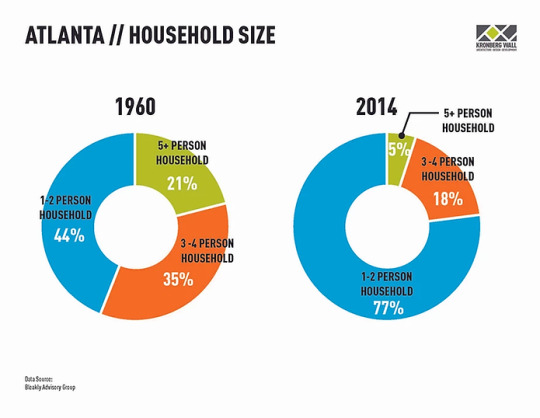
Source: Kronberg Urbanists + Architects (Click the image to view their website)
In summary: to build smaller, more affordable homes in urban neighborhoods, get rid of minimum lot size requirements, allow up to four units on any residential lot, and eliminate parking minimums. It won’t solve all of our urban housing problems, but it will make it easier to build quality, affordable housing in desirable neighborhoods.
Sources & More Reading:
Minimum Requirements for Lot and Building Size, American Planning Association (APA)
Missing Middle Housing
The Affordable Housing Crisis Explained, Curbed
Cities Start to Question an American Ideal: A House With a Yard on Every Lot, New York Times
Richmond 300: Land Use, Housing, & Demographic Analysis
Housing Choice & Healthy Neighborhood Development, Kronberg Urbanists + Architects
0 notes
Text
Dead-ender litigation won't make housing more affordable
I don't know what will make housing less expensive around me, but I am sure that a ticky-tack ruling from a judge won't help matters.
It will take a little longer for a slightly freer housing market to provide some possibly cheaper new homes in Arlington now that a judge has thrown a stop sign in front of my county’s attempt to allow multiple-family housing on lots formerly reserved for single-family housing. Retired Fairfax County judge David Schell (picked by Virginia’s Supreme Court after all of Arlington’s active judges…

View On WordPress
#Arlington#Arlington County Board#by-right#duplex#EHO#expanded housing options#missing middle#NIMBY#teardown#triplex#YIMBY
0 notes
Text

ADUs in Cleveland. My tour of American cities continues.
0 notes
Text
Watch the progress at our East 31st street project! We are thrilled to be developing affordable workforce housing that is well-located and designed with the human experience in mind. Our mission is to support the health of communities by providing critical service providers with the opportunity to live where they work. We partner with cities, community stakeholders, and local employers to create affordable housing for working families.
We use modular construction techniques and highly efficient templated design to drive affordability at scale, all while remaining focused on the human experience. Our goal is to accelerate infill development of workforce housing for the “missing middle”.
Are you interested in learning more about our exciting project? Feel free to message me here or visit our website at www.dkaufmandevelopment.com.
#real estate#investment#economy#housing#housing forecast#danielkaufmanrealestate#daniel kaufman#homes#construction#real estate investing#affordable housing#modular construction#missing middle#technology
1 note
·
View note
Text
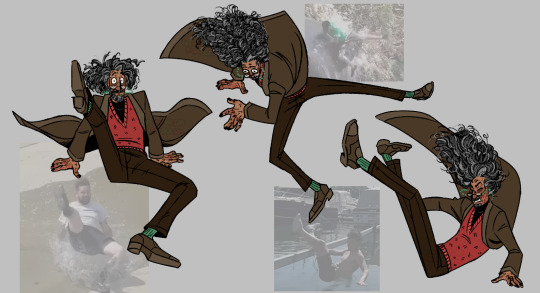
[ID: Three digital drawings of Jonathan Sims from The Magnus Archives as he is in season 4 falling down in various poses. There are low-opacity reference photos next to each drawing. end ID]
~~~~
references taken from various fail clips. he falled down.
#fg's art#the magnus archives#tma#jonathan sims#i missed this guy#the middle one kinda looks like he's breakdancing lol
2K notes
·
View notes
Text



It's ok, Minato asked for permission first
#naruto fanart#naruto#naruto uzumaki#uzumaki naruto#fukasaku#I know the headcanon that Minato got the “flee on sight” order because he killed a thousand iwa nin (in the anime) is super popular#but I always thought it was more likely that he got that order on him because anyone he touched became a security risk#I know in my heart Minato learnt how to teleport bijudamas by using the Hiraishin and sending them to Iwa#Minato put a finger on you? good luck#now if you ever put a foot in your village it can and will get nuked :)#or in the best-case scenario he will simply appear in the middle of your camp and murder all of you#I also like the idea of Minato putting a kunai in the middle of one of the oil ponds in Mount Myoboku#and use the Hiraishin to send his enemies there#puff now you're a toad statue#ahh so many possibilities...#Kishi missed making Minato a true nightmare in the 4th war *sigh*#I understand though. A clever Minato with the Hiraishin would be too OP#they had to dumb him down. Cowards all of them *sigh again*#my hate for that arc knows no bounds#but it's ok it's ok I got your back Minato <3#also updating the tags a day later because I totally forgot to talk about the drawing itself lol#but I think it’s actually extremely weird that supposedly so many people turned to stone while training with the toads#the scroll Naruto signed only had 5 names on it despite being passed down for generations#and even if there were more scrolls around or people simply went to Mt Myoboku to train in senjutsu#I don't think the toads would let them turn into statues???#they clearly care about their students and go through great lengths so Jiraiya DOESN'T turn to stone while using SM#so there being so many statues around of people failing SM training never made much sense to me#so I decided Minato (during the 3rd war) was the one responsible for that#he deserves it ✨
2K notes
·
View notes
Text

waiting for ladynoir to come back from the war..,.
#duck scribbles#miraculous ladybug#mlb#ladynoir#i remember clearly my middle school best friend who made me watch ml with her despite my desperate avoidance up til then tried to get me#into ladrien like her but i latched onto ladynoir like a clam instead. i miss them so bad#marinette dupain-cheng#adrien agreste#ladybug#chat noir
1K notes
·
View notes
Text
Adding onto this, urban infrastructure in the US and Canada is such a waste of space (coming from someone with a special interest in city design, car dependence and cycling infrastructure etc.). There's this thing called the "missing middle". Due to stupid zoning rules only certain types of houses can be built in certain places. This has led to swaths of single family homes in suburbia (the death of cities) or high rise apartments. But you're missing this middle type of house. Smaller houses, that perhaps are joined together, or are close together. The perfect kind of house for the majority of people!
Unsurprisingly it all boils down to money. It's not cheaper for the government to do this, but it is for car and gas companies...
This might sound like a side tangent but it isn't! The more separated people are (suburbia) the more car dependent they are, so car and gas companies make more money.
This is also the case with road layout and design. But I could go on for a while and as I'm writing this it's very late and I should be asleep not talking about infrastructure 😅
(NotJustBikes and ClimateTown are good YouTube channels that explain these issues in an interesting way, so I highly recommend checking them out)
Our use of land in the USA is such a mess. Some of our land we struggle endlessly to cause it to produce resources, and with other land, we expend resources on sterilizing it.
#urbanism#urbanization#infrastructure#car dependency#suburbia#road cycling#not just bikes#climate town#space management#missing middle#land use#ramblings#rambles
174 notes
·
View notes